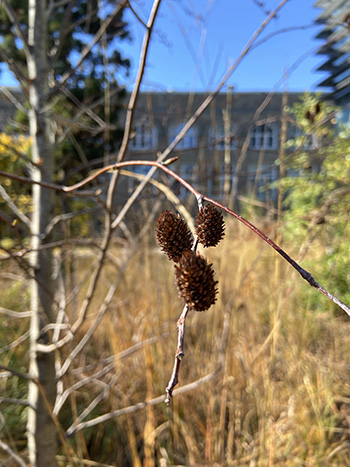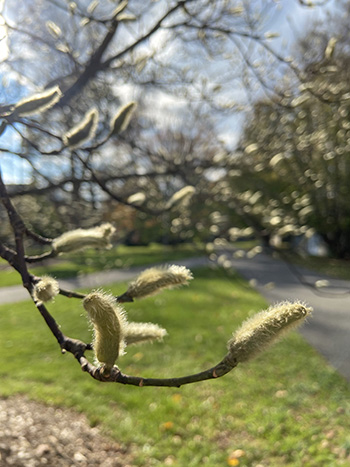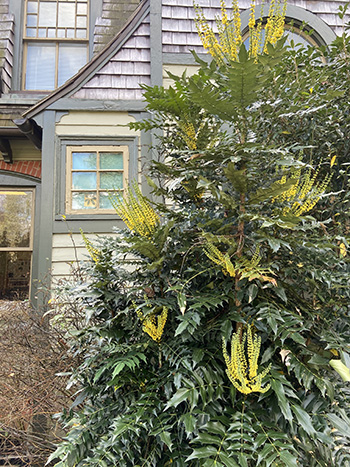
Plants of the Week: Nov. 14

Betula lenta (sweet birch)
This past week, the Scott Arboretum hosted some students from Wallingford Elementary School for a field trip. I had the opportunity to work with one of the gardeners, Lars Rasmussen. As we were walking from one demonstration area to the next, Lars reached over and pulled a leaf off a Betula lenta tree and handed it to the kids. Their faces instantly lit up as they smelled the fragrant leaf. Most called out saying that it smelled like root beer, coca cola, even birch beer.
Now used primarily as a shade tree and an occasional source of dark wood for furniture, the Betula lenta was used to produce birch oil, or oil of wintergreen which would flavor medicines and candy. Tapping the tree, similar to that of the sugar maple, gives way to a fermented sap that creates birch beer.
Betula lenta on campus can be found in various locations around the Scott Arboretum, but we have a nice collection of young trees in the Singer Hall landscape on the south side of the building. Most of the specimens have lost their leaves and are now sitting bare except for the female catkins standing small and tall. If you happen to come across a tree that is still carrying its leaves however, I encourage you to press a leaf between your fingers and smell the delicious scent of the sweet birch tree. Photo credit: M. Rossman

Magnolia x kewensis ‘Wada’s Memory’ (Kew magnolia)
As we all start to pull out and dust off our fuzzy winter coats, so do the plants! One magnolia in particular has adorned itself with many “fuzzy little coats.” The Magnolia x kewensis ‘Wada’s Memory’ is most celebrated for its spectacular spring flower display, but right now I simply cannot get enough of the bud scales that are at the terminal points of all the branches.
Magnolia trees have two different kinds of buds; the flower buds, which are bigger and open earlier in the season, and the leaf buds. The furry buds we see now on this hybrid magnolia are the flower buds which will open up in the spring. To protect them through the cold winter, the furry covering, known as a bud scale, helps to insulate the blossom from the elements like a thick, warm sweater.
And it’s a good thing the blossoms are being protected, because come spring, the Magnolia x kewensis ‘Wada’s Memory’ will be covered with showy, 7 inch, upward facing, snow-white blossoms. So while we lie in wait for the scented profusion of flowers come spring, come enjoy the full season interest of this hybrid magnolia through its adorable, fuzzy bud scales. Photo credit: M. Rossman

Mahonia x media ‘Charity’ (hybrid mahonia)
Each week there is a new late-fall, early-winter fragrant specimen blooming. Last week it was the witchhazels and this week it is the Mahonia x media ‘Charity’. I know we have many more fragrant winter blooming plants to come, but this is certainly one to beat, with its elegant soft-yellow spires, attractive evergreen foliage, and statuesque appearance.
Its dark-green leaves are composed of 17-21 leaflets and the ‘Charity’ cultivar is known for its upright growing habit. This plant is located near the Cunningham House front entrance and is looking fantastic with the yellow planting theme of the Scott Entrance Garden. The slender spikes of sweetly scented flowers open over an extended period of time and are such a delight to walk by while making my way to the arboretum offices.
This shrub grows up to 20 feet tall and wide and is a full-sun to partial-shade lover. It grows in fertile, humus-rich, moist or well-drained soils and does best when it can be protected from harsh winds. It is noted for several tolerances, including deer, rabbit, drought, and pollution. This mahonia looks great as part of a mixed border, providing a reliable green background during the summer months and then really drawing your attention, as it is doing now, with those beautiful flowers. Photo credit: M. Rossman





No Comments